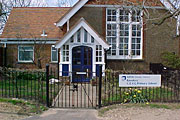Designing and Creating Emails
The emails we send are HTML-Emails which allow colours, fonts, pictures, etc.
If you compose a simple letter-type mail in Word (paragraphs and headings) with up to 3 pictures; we will convert it to HTML-Email free of charge.
If you want to use something more graphically complex you can do it yourself or get your Graphics / Design department / company to create it according to the following guidlines:
Requirements for Creating HTML emails to be sent to schools or to anyone else
1. Do not use CSS Styles in the construction of emails; use simple html tags to set fonts, colours, etc.
'inline' Styles are OK.in Dreamweaver: Edit -> Preferences
Untick . . . 'Use CSS Styles instead of HTML tags'
2. Pictures should be linked in from a website with full http:/... URL; and not embedded in the email.
3. Don't use Background images as we find they rarely display properly.
4. If you wish your email to print out properly when received in school, (this is often a way mail is circulated in school) then you should contain the whole email in a 640 pixel wide box / table cell.
Marketing theory says that long lines of text are more difficult to read than short lines / columns of text, like this. For the same reasons, emails should be 'portrait' shape rather than 'landscape'5. Word docs and PDF brochures can be sent as linked attachments, mounted on your server (or ours; no extra charge) and then linked into the email, so readers can click, read and print if they wish.
6. EC Regulations say that your registered company name, number & address should appear at the bottom of the email.
e.g. Deepspace Web Services. 27 Cecil Road, Norwich, Norfolk, NR1 2QL. Registered in England
.The most effective mail is:
1. concise ... short & to the point ... should show all the main features of your offer clearly.
2. contains an image which will attract attention or impress;contains your clickable email & web addresses; from a named sender rather than just company name;
3. minimises effort needed to respond by customers; i.e. "click here and email us your name & school address" is likely to get more response than a more complex system or a 'print, fill-in and post' form.See example emails: Example Emails
Avoiding Spam Filters:Certain words and effects used in emails are likely to trigger some spam filters which some schools use. The best way to check is to send the email to yourself and see if your own filters notice it. The strongest effect on spam filters comes from mails which come from known anonymous spam-servers. If you/we send from our own email addresses, things should be OK.
Try to avoid:
- WHOLE LINES OF CAPITALS;
- too high a graphics to text ratio; eg. 80% graphics 20% text
- fonts bigger than size 3; use H1 H2, etc. instead
- words like FREE SPECIAL OFFER and RED
Use one of the various free Spam Test facilities available on the Internet.
More Notes for Designers creating html emails.
- If you are sending a graphically complex html email; bear in mind that some schools convert it into a plain-text email which will probably look a mess.
The solution to this is to put a line at the top which says something like 'If this email does not display properly please click here' ... linked to a copy of the page on your webserver. See: samples for many examples of emails which do this.
See example emails: Example Emails.
How to make your own HTML Emails
1. Buy a copy of Dreamweaver (expensive) or other Web-page editor and build the page yourself. It is as easy as typing in Word. Type text, set fonts, colours, etc. and insert pictures.












